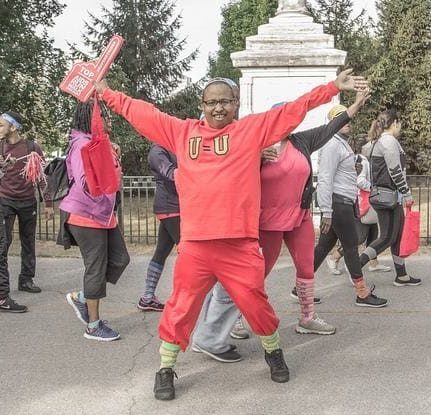“Scientific advances have shown that antiretroviral therapy (ART) preserves the health of people living with HIV. We also have strong evidence of the prevention effectiveness of ART. When ART results in viral suppression, defined as less than 200 copies/ml or undetectable levels, it prevents sexual HIV transmission. Across three different studies, including thousands of couples and many thousand acts of sex without a condom or pre-exposure prophylaxis (PrEP), no HIV transmissions to an HIV-negative partner were observed when the HIV-positive person was virally suppressed. This means that people who take ART daily as prescribed and achieve and maintain an undetectable viral load have effectively no risk of sexually transmitting the virus to an HIV-negative partner.”
Let’s break this down.
We have long known that antiretroviral therapy (ART) for people living with HIV, like me, helps us stay healthy and live long and strong. That’s not news.
And the part about undetectable viral loads isn’t exactly a newsflash either. The evidence has been mounting for some time that people living with HIV on successful antiretroviral treatment – meaning their viral load is undetectable for at least six months (virally suppressed) – are not capable of transmitting HIV sexually to their HIV-negative partners.
When the CDC released this statement, it wasn’t only due to the overwhelming scientific evidence, it was because of massive community engagement and mobilization the world over – loud, noisy, science-based ACTIVISM. This activism forced them to update their outdated messaging with scientifically accurate language concerning HIV transmission. Check out the Prevention Access Campaign at preventionaccess.org to see where all this beautiful noise came from.
In case you missed it: Undetectable = Untransmittable. U=U! Toot toot, hey, beep beep!
This is HUGE for all of us living with HIV and it is HUGE for all of us who serve communities of people living with HIV, including those who are vulnerable to acquiring HIV. It is cause for celebration. Many (if not all of us) living with HIV have been considered “armed and dangerous” by far too many in the general public for decades. We have been treated like viral demons, vectors of disease, and untrustworthy. We have been criminalized (in fact, some states still have laws on the books that criminalize HIV positive people.) Celebrating this amazing milestone is necessary.
Now, let’s focus on how U=U should impact our delivery of HIV care services to people living with HIV. Here are some “musts” on my list.
1. All people living with HIV must have access to this information. There is no acceptable reason to withhold it.
2. All people working the HIV field, serving both HIV-positive and HIV-negative individuals, must know this information and share it (see #1.)
3. This information must be shared widely through public health education and social marketing campaigns everywhere people are living with HIV.
4. We must clearly and unequivocally state that viral suppression (undetectable = untransmittable) is safer sex. Period. Condoms do not need to be part of the equation here, and condoms are not the only means of having safer sex. Viral suppression in and of itself is safer sex. Period.
5. While we celebrate loudly, we must take care to not create new ways to stigmatize people living with HIV. The truth is, not everyone living with HIV on ART will achieve an undetectable viral load for a whole host of biological or societal reasons. We must not shame or judge them. It is not a moral failing to have a detectable viral load. It does not make you a bad person. HIV is a tough customer, and the meds used to treat it don’t work for everyone all the time. And many people with HIV are struggling with behavioral health issues, homeless, poverty or other issues that get in the way of HIV treatment, and can’t be solved overnight.
6. We must not coerce anyone living with HIV into treatment. While we know there are many benefits to ART – individual and community benefits – going on treatment MUST be a decision made freely by the individual.
There’s been considerable debate in the community about how quickly people with HIV should start HIV treatment. Some cities and clinics have developed admirable programs to provide HIV medications the same day they are diagnosed with HIV. That’s a great option for some people.
But not everyone is ready to start ART the day they find out they’re positive. Some folks want to start right away, others want to wait. Waiting is valid – a person may have other issues they want to address first, they may want to deal with the shock and awe of learning their status first, they may want to cry for a while. They may want to curl up in the fetal position for a minute, they may want to grieve.
Testing positive is still a big deal. And let’s be honest, someone just learning they have HIV may not be quite ready to contemplate a lifetime of pill taking. ART is a “forever marriage” – once you start you will be on meds the rest of your life. This fact may change at some point in the future – but that is a fact today and it will be the same tomorrow. And likely for years to come. We must not set up “shotgun marriages” between a positive person and ART. It MUST be a marriage entered willingly, eyes wide open. Forcing/coercing someone to do something they are not ready to do will have negative consequences.
At the same time, it’s critical to get people connected to medical care and supportive services as rapid as possible, even if they aren’t ready to start treatment. Medical and supportive services are, after all, not defined by or limited to ART. The National HIV/AIDS Strategy aims to link 85% of people newly diagnosed with HIV to medical care within one month of their diagnosis. Chicago fell just short of this goal in 2016, with 80% linked to medical care 30 days after diagnosis.
We must always remember to meet people where they are, not where we want them to be, or where we think they should be, but where they are. Respecting people’s priorities and helping them reach the goals THEY set is what is important – and the odds are, if we do this, we will also be successful on the HIV treatment side.


